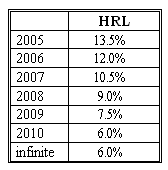Why should I choose AnalystNotes?
AnalystNotes specializes in helping candidates pass. Period.
Basic Question 2 of 7
Beth is evaluating HRL Co. which has been growing at the annual rate of 15% for the last 5 years. Here is her forecast of the company's future dividend growth trend.

After considerable study, she has decided to use the following information in her valuation (as of the end of 2004):
- Beta: 1.2.
- 2004 dividend: $5.
- The risk-free rate: 4%.
- Expected equity premium: 6%.
What is the value of the HRL's stock?
User Contributed Comments 9
| User | Comment |
|---|---|
| YeahMe | gs=15%? , I think it should be 13.5%. Anyone please help. Thanks |
| tengo | the growth rate after the first year of decline is 13.5% . It was growing 15% before that time. That % is in the narrative not the table. A bit tricky. |
| Lavay | The last 5 yrs statement in the narrative could be confused for H, whislt the actual transition period is (2005-2010=6 yrs). |
| jhmorris | Am I missing something here? Rather than using the H-model, I simply set up the cash flows (as listed below) and discounted them back at 11.2% to generate a value of $123.86. Could this simply be due to the approximate nature of the H-model? CF 1 (2005) = 5.675 CF 2 (2006) = 6.356 CF 3 (2007) = 7.02338 CF 4 (2008) = 7.6555 CF 5 (2009) = 8.2296 CF 6 (2010) = 8.7234 + 177.8231* * Terminal Value = 9.246804 / (0.112 - 0.06) |
| Rotigga | I did the exact same work as jhmorris and arrived at $123.86; remembering the H-model formula will probably save some time on the exam though |
| creativemny | In order to use the H-Model the decline of supernormal growth is assumed to be linear. Not sure how this question indicates use of the H-Model. |
| gaai | By starting with 13,5% you get 123.56 which is much closer to the "actual number" 123.86 The 15% is just a history and then Do = 4.35 |
| davidt876 | i screwed this up and then looked into it. the question is right, and we should use 15% because it's the current growth rate, and $5 as it's the current dividend. and i think i figured out why the valuations are so different. we are treating the dividends paid from 2004-2010 as a continuum, and not as distinct payments at t=1, t=2... basically we are valuing the dividends as if they were spread equally throughout the year - and not paid at the end of the year. time value of money says if we get paid sooner it increases PV, so H-Model produces a higher PV. and in my opinion it's an artificially higher PV. but there is logic to it because we're treating the abnormal growth period in the same way we do the constant growth period under GGM. if you really are interested in seeing the logic behind the H-model, go on excel and enter the below data: A(yr) B(r) C(g) 2004 1.12 1.150 2005 1.12 1.135 2006 1.12 1.105 2007 1.12 1.090 2008 1.12 1.075 2009 1.12 1.060 2010 1.12 1.060 2011 1.12 1.060 plot the above on a line graph and you should see the straight line of r, crossing the ‾\_ looking line of g. GGM formula: V2010 = D2010 * (1+g) / (r-g) if we abstract the above formula while looking at the graph we could say that V2010 is equal to D2010 multiplied by the area under the line 1+g, divided by the area between 1+r and 1+g. area under line 1+g = height*base = (1+g)*infinity, divided by area between 1+r and 1+g = height*base = [(1+r)-(1+g)]*infinity = (r-g)*infinity base = infinity because it's a perpetuity. so: V2010 = D2010 * (1+g)*infinity / (r-g)*infinity or: V2010 = D2010 * (1+g)/(r-g) * infinity/infinity so it's still GGM because infinity/infinity = 1. now we can agree that the GGM can be abstracted as the area under 1+g divided by the area between r-g. so we look back before 2010, and figure we can calculate the area under 1+g all the way back to 2004 and divide it by area under r-g. GGM value of constant growth starting from 2004: V2004 = 5*(1.06)/(0.112-0.06) = 101.92 now we need to add the GGM estimation of the abnormal growth which forms a triangle above the rectangle of constant growth. the area is 0.5*base*height: base = 2010 - 2004 = 6 height = (1+gS) - (1+gL) = gS - gL = 0.15-0.06 = 0.09 Value of abnormal growth from 2004 to 2010: V2004 = D2004 * (0.5*base*height) / (r-g) = 5 * (0.5*6*0.09)/(0.112-0.06) V2004 = 25.96 Add them up = 101.92 + 25.96 = 127.88 |
| ashish100 | ^ this guy is on some super potent ADHD medicine if I had to bet. Who has time to type a research report in the comments. Don't even read it coz its so long. CFA should hire him write their material. Probably would make it even longer lol jaisus |

I used your notes and passed ... highly recommended!

Lauren
Learning Outcome Statements
explain the assumptions and justify the selection of the two-stage DDM, the H-model, the three-stage DDM, or spreadsheet modeling to value a company's common shares;
describe terminal value and explain alternative approaches to determining the terminal value in a DDM;
calculate and interpret the value of common shares using the two-stage DDM, the H-model, and the three-stage DDM;
explain the use of spreadsheet modeling to forecast dividends and to value common shares;
evaluate whether a stock is overvalued, fairly valued, or undervalued by the market based on a DDM estimate of value.
CFA® 2025 Level II Curriculum, Volume 3, Module 21.